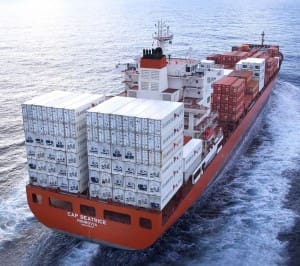 AUSTRALIA’S lamb exports October were slightly lower than last year, but still higher than the average shipments for the month over the last five years.
AUSTRALIA’S lamb exports October were slightly lower than last year, but still higher than the average shipments for the month over the last five years.
And the prospects are reportedly good for continuing strong demand into key markets.
Meat & Livestock Australia said despite the seasonal increase in spring lamb supplies, and consequent higher export volumes, Australian lamb shipments in October of 21,234 tonnes remained 2 percent below the level in October 2015.
But MLA said Department of Agriculture and Water Resources showed the October 2016 shipments were up 7pc on the five-year (2011-2015) October average. Due to higher year-on-year volumes shipped during the first six months of the year, the January to October total remained 1pc above the corresponding period last year.
MLA said the largest growth markets for the year-to-date include China, the US, Japan, Korea and Papua New Guinea. Although the volume to the Middle East as a whole is lower year-on-year for the ten month period, the UAE and Qatar have also recorded strong growth.
Total chilled lamb exports for the year-to-October eased 2pc year-on-year to 82,773 tonnes – with increased chilled shipments to the US and Korea not enough to offset the declines to the Middle East and the EU. Frozen lamb volumes for the year-to-date rose 4pc to 112,769 tonnes, largely driven by year-on-year increases to China, the US, Korea, the EU and Japan.
MLA said lamb exports to the Middle East for the January to October period were 10pc lower than the corresponding period last year at 51,962 tonnes. The majority consisted of chilled product (43,492 tonnes), which eased 6pc year-on-year, while frozen volumes of 8470 tonnes were down 27pc. Most of the decline to the Middle East was attributed to a 92pc drop in shipments to Bahrain for the year-to-date – from 7419 tonnes in 2015 to 593 tonnes in 2016 – due to the lifting of the government subsidy on imported Australian lamb.
Strong growth into Middle Eastern markets
MLA said two of the largest and most progressive markets in the Middle East for Australian lamb – the UAE and Qatar – recorded considerable growth for the January to October period. Volumes to the UAE were up 12pc year-on-year to 17,090 tonnes. Lamb shipments to Qatar increased 13pc to 13,584 tonnes.
Lamb shipments to the US lifted 8pc year-on-year, reaching 42,917 tonnes for the year-to-date. MLA said the proportion of Australian chilled lamb exports to the US tended to increase in October, ahead of the Thanksgiving holiday season (also in February, ahead of Easter). For the January to October period, US chilled and frozen volumes increased – up 7pc and 8pc, respectively, to 23,267 tonnes and 19,650 tonnes. Assorted cuts, shanks, manufacturing and carcases recorded the greatest growth so far this year.
MLA said lamb demand from China has strengthened this year, with shipments up 21pc for the year-to-date to 31,326 tonnes – all of which was frozen product. Volumes of breast and flap to China increased 7pc year-on-year to 19,360 tonnes, while manufacturing product tonnage increased 41pc to 5974 tonnes. Shipments of neck increased 20pc to 3150 tonnes, and shoulder demand recorded a more than four-fold increase to 2389 tonnes for the January to October period. Reports suggest that importers are anticipating good demand for sheep meat during the upcoming cooler months, MLA said.
Korea has been a significant growth market for both Australian beef and lamb exports in 2016, MLA said. Lamb shipments to the country for the year-to-October jumped 37pc on the same period last year to 6636 tonnes. MLA said in-market reports attribute the growth to expansion in the food service and retail sectors, with several Korean hypermarkets now selling chilled product in store.
Australian chilled lamb exports to Korea have more than doubled year-on-year to 1338 tonnes for the ten-month period, while frozen exports were 26pc higher at 5298 tonnes. For the year-to-date, volumes of breast and flap almost doubled to 1578 tonnes, shoulders increased 39pc to 3427 tonnes, and rack shipments jumped 81pc, to 472 tonnes.
MLA’s recently released export snapshots provide a regular up-to-date picture of Australia’s red meat export portfolio.
Click here to access the latest snapshots for:
Source: MLA.



HAVE YOUR SAY